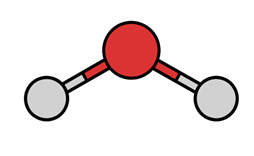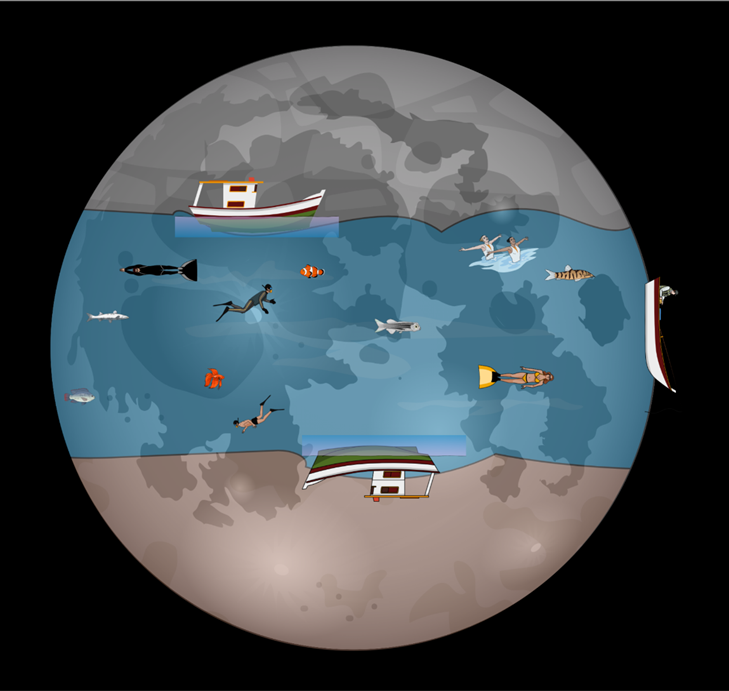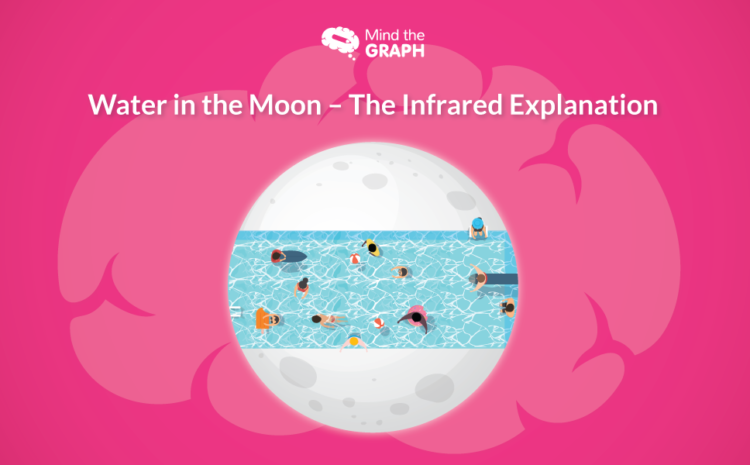Greit, greit, kanskje jeg overdriver litt på bildet over - en enorm mengde vann, fisk, båter og svømmere som har det gøy i en måneelv.
But all I was trying to say is that on October 26, 2020, Nature Astronomy published a study affirming that they have detected water in the Moon. Actually, it was not any water, it was molecular water – the smallest unit of it.

Studien bekrefter å ha oppdaget vann i visse kratere på månen ved hjelp av et infrarødt kamera ved navn FORCAST som ble koblet til teleskopet SOFIA 31. august 2018.
Kameraet detekterte et sterkt 6 µm-emisjonsbånd, som ble sammenlignet med andre studier og med litteraturverdier, noe som bekrefter at dataene er gyldige.
En enkel forklaring på infrarød analyse er at den omfatter et bredt spekter av det elektromagnetiske spekteret, fra 14000 til 10 cm-1, som i bunn og grunn er en måling av energi, og hvordan den interagerer med materie.
Denne interaksjonen kan skje ved absorberende, emitterende eller reflekterende some level of energy. This measurement can identify not only an unknown molecule but also the characteristics of it.

Det sterke 6 µm-emisjonsbåndet som FORCAST detekterte, er fra et bestemt område av det infrarøde båndet, det midt-infrarøde, fra 4000 til 400 cm-1.
Denne delen brukes vanligvis til å observere og analysere fundamentale vibrasjoner associated with molecular structure. It is possible to analyze substances in any form – solid, liquid, or gaseous.
Siden slike molekylvibrasjoner er mye brukt til å studere molekylstrukturer, er det kjent at et enkelt molekyl kan absorbere, avgi eller reflektere energi i en bestemt frekvens som samsvarer med spesifikke strukturelle egenskaper.
This happens because molecules are not static objects, their chemical bonds between atoms are in constant motion, they are dynamic and interact with different levels of energy.
Vannmolekylet kan for eksempel vibrere på tre forskjellige måter. To av dem er forlengelse og strekking av oksygen-hydrogenbindingen, og den siste er vinkeldeformasjon.
Ok, la oss ta det rolig nå: Vannmolekylet har to bindinger, ikke sant? Ja, det har det.
Disse to kan bevege seg på en symmetrisk måte, med opp- og nedturer samtidig, og på en asymmetrisk måte, der den ene obligasjonen går opp mens den andre går ned.
These two types of vibrations are the symmetrisk strekk og asymmetrisk stretch. Den tredje vibrasjonen er ikke en opp- eller nedadgående bevegelse, men mer en vinkelbevegelse, som en svingning, kalt symmetrisk deformasjon.

Hvis du vil se gifs for å få en bedre forståelse av hva slags vibrasjon molekylet har, kan du sjekke det ved å klikke på navnene ovenfor i teksten.
La oss nå gå tilbake til artikkelen.

Det sterke 6 µm-emisjonsbåndet ble observert i et bestemt område av månen, i Clavius-krateret og det omkringliggende terrenget som ligger på høye breddegrader.
For å forsikre seg om at de virkelig så på et infrarødt H2O-bånd, brukte forskerne tidligere data fra vannholdige materialer for å bekrefte egenskapene til månebåndet. De undersøkte også planetens eksisterende materiale for å se H2O-båndet på 6 µm og sammenligne det med båndet som ble oppdaget. Basert på disse sammenligningene bekreftet de at båndet stammer fra molekylært vann.
Dette båndet var imidlertid ikke det eneste som ble oppdaget på måneoverflaten. Et annet absorpsjonsbånd på 3 µm ble oppdaget, og det kan bety mer vann.
Dette andre båndet var til stede nær Månens ekvatorområde, på et annet sted enn det første båndet.
Det ser altså ut til at plasseringen endrer seg mye i dataene som forskerne har samlet inn.
Til forskjell fra 6 µm, som er et svært karakteristisk bånd for vannmolekylet, representerer dette 3 µm-båndet et molekyl som kan omdanne det til vann, nemlig hydroksyl (O-H).
Det betyr at vannet også kan dannes ved kjemiske omdannelsesreaksjoner fra hydroksyl til vann på måneoverflaten.

Du spør kanskje: "Hvordan er det mulig å ha vann på måneoverflaten?" Eller til og med "Hvor kom vannet fra?" Vel, i artikkelen har de en teori.
"Det er flere mekanismer for opprinnelsen til vann i månejord som er relevante for våre data", heter det i artikkelen, og videre: "Vann som finnes i månens eksosfære, kan kjemisorberes på kornoverflater.
Vann kan tilføres av flyktige mikrometeoritter, og en del av dette vannet kan bli værende i glassene fra disse nedslagene eller føres inn i eksosfæren, hvor det er tilgjengelig for kjemisorpsjon" (HONNIBALL et al., 2020).
Vannet kan med andre ord komme fra mikrometeoritter, og når de knuses på måneoverflaten, blir molekylene holdt tilbake i noe forskerne kaller glass og kornoverflater.
Dermed konkluderer resultatene i den publiserte artikkelen på en konsistent måte med at det finnes en eksisterende mekanisme som produserer vann på måneoverflaten ved sammenstøt.
Men dessverre er progresjonen i denne prosessen svært liten, og kanskje kommer vi aldri til å se en svømmekonkurranse på månen. Beklager, folkens, vi må nøye oss med våre vanlige bassenger, strender, elver og hav.
Hvis du vil lese hele artikkelen og få mer informasjon, finner du den her:
HONNIBALL, C. I. et al. Molekylært vann oppdaget på den solbelyste månen av SOFIA. Astronomi i naturen, s. 1-7, 26 ut. 2020.
Now if you want to do a cool picture like those you have seen here, you can try to Mind the Graph! Mind the Graph is a platform that allows you to present your research project, digital content in a more visual and attractive way, try to Mind the Graph! Click her å begynne å bruke den.
Og hvis du er en kjemiker som meg, kan du bruke Galleri for kjemi I arbeidet ditt trenger du ikke lenger lide for å lage molekyler, her kan du få vakre molekyler og strukturer. Sjekk Mind the Graph.

Abonner på nyhetsbrevet vårt
Eksklusivt innhold av høy kvalitet om effektiv visuell
kommunikasjon innen vitenskap.




